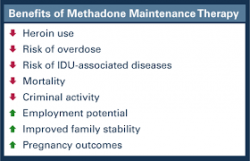How Methadone is Now Used for Opiate Addicted Drug Offenders
According to the National Library of Medicine, many prisons are experimenting with methadone maintenance treatment for inmates who have an opiate addiction.
What is Methadone Maintenance Treatment?
Methadone maintenance treatment is a popular treatment for opiate addiction. It involves the administering of methadone, usually daily, to prevent opiate withdrawal and treat chronic pain. This practice started in the 1960s and continues today.
Methadone maintenance treatment is a proven way for opiate addicts to stop using both legal and illegal opiates. It also helps to prevent overdose and relapse back into drug use. Unfortunately, methadone itself is an addictive substance so the treatment is not perfect.
Why use Methadone Maintenance Treatment?

There are many benefits of Methadone maintenance.
The number one reason to use methadone maintenance treatment is because it stops opiate withdrawal. Many opiate addicts decide against quitting because they fear the consequences. Opiate withdrawal although not deadly is extremely unpleasant. It involves symptoms such as:
- abdominal cramping,
- joint pain,
- nausea,
- vomiting,
- diarrhea,
- depression, and
- anxiety.
Although these are not all the symptoms of opiate addiction, these are usually the worst. Taken individually they do not seem very bad but it is important to remember that all the symptoms usually happen at once and to an extreme.
In order to prevent severe illness and illegal drug use in prisons, methadone is sometimes used to keep inmates from going through withdrawal. Since methadone is a proven treatment for opiate addiction, it makes sense to use it to detox the prison population.
How does Methadone Maintenance Treatment work in Prisons?
Methadone Maintenance in prisons is similar to methadone maintenance out of prison. The prisoners are given methadone daily under controlled circumstances. A prison doctor prescribes the methadone in carefully controlled doses. Once the correct dose to stop withdrawal is found, the doctor then starts to taper the addict off the methadone so the detox process does not involve severe withdrawal symptoms.
Why use Methadone Maintenance in Prisons?
Although it is illegal, it is possible to get opiates in prison. These prisoners often wind up using low-grade opiates that can be extremely dangerous. By using methadone to treat opiate addiction, it is possible to help prisoners stop using these opiates. Most prisoners who participate in methadone maintenance treatment stop using opiates in prison and keep their sobriety when they leave the prison system.
Another benefit to methadone maintenance is it helps to prevent the transmission of HIV in prison. Many prisoners find ways to inject drugs like heroin and other opiates. This helps spread the HIV infection. According to the National Institute on Drug Abuse, Methadone maintenance prevents prisoners from using these needles and therefore helps to prevent the spread of HIV.
Although it is not a perfect solution, methadone maintenance in the prisons system helps prevent a lot of the problems associated with opiate use. It also helps drug offenders exit prison in a drug free state. For more information on methadone use in prisons, feel free to call use at 1-800-994-1867Who Answers?.